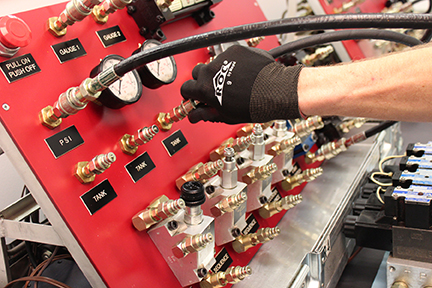Joyce Laird • Contributing Editor
What are the top issues that can cause hose failure?
Advanced Technology Services (ATS) is a leader in factory maintenance and IT services, with strategically diversified services and a rapidly growing workforce spread across three countries. Today, ATS works with some of the largest brands in the world to make their business run better, which includes proper functioning of all plant hydraulic systems.
Scotty Garst, general manager at ATS, explained that the causal issues that top the list of hydraulic hose failures in most factories are caused by either improperly assembled hose components or the selection of improper hose components. “The root cause of hydraulic hose failures can usually be traced back to poor preventive maintenance inspections, training of the workforce and lack of procedure documentation,” he said.

What are the key things you can do to avoid hose failure?
“At ATS, we believe that implementing a good preventative maintenance program with detailed machine specific instructions and standard work tasks, is extremely important. We do this for all equipment during the integration of our maintenance programs. This quite often leads to finding these issues prior to a critical failure,” he said.
He went on to say that preventing hydraulic hose failures and other similar interrupters to operations are common reasons companies choose to partner with ATS, because the company focuses on “properly training our skilled workforce and documenting standard work for common activities such as hydraulic hose assembly and inspection.”
Training the workforce on proper techniques through the ATS internal SkillPoint training courses, as well as documenting standard components selection and assembly procedures are two of the methods ATS has had much success with over the years. “Additionally, we are also using new technology, like that of partner companies that offer special technologies that are designed to provide real-time monitoring of hose condition and alert equipment operators when failure is imminent,” Garst said.
Closing recommendations
In conclusion, Garst believes that almost all hydraulic hose failures can be prevented by implementing and continuously improving a preventive maintenance and inspection program, focused workforce training and development of standard procedures. “The time and effort the company puts into this, will yield significant cost reduction over time,” he said.

In terms of early failure of a hydraulic hoses, I would agree. The root cause of operational failure is a poorly routed hose that puts strain at the fitting end. Elbow fittings in the wrong orientation, or making 90 degree bends with straight fittings cause unnecessary premature hose failure. Too many times, users will repeatedly assemble the wrong configuration for an application and have repeat failures, usually from the same mode. Most hose/fittings manufacturers have simple to read assembly charts like this one from Gates:
http://www.gatespowerpro.com/resources/doclib/HoseRoutingTips.pdf
Having one of these laminated and posted next to the hose machine remind technicians to think through their fitting choices, hose lengths, etc. A robust maintenance system should describe the proper lengths and fittings needed for hose applications, but in case of a temporary repair or equipment modification, these basic tips work great.